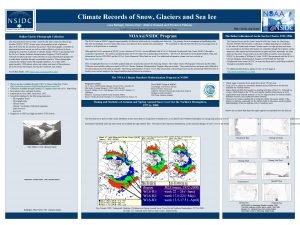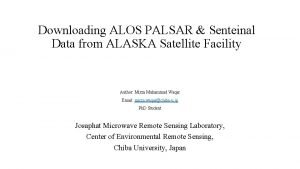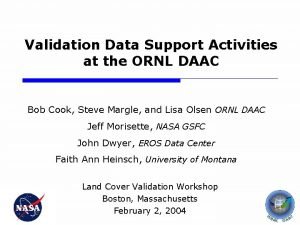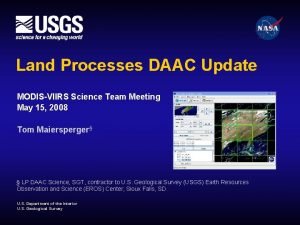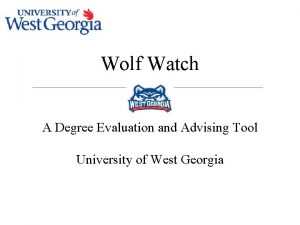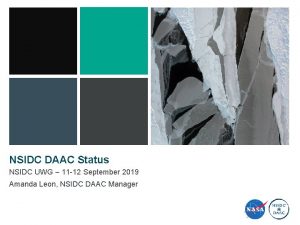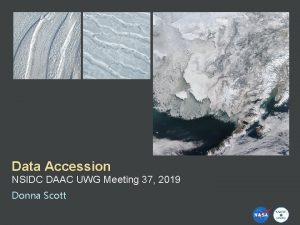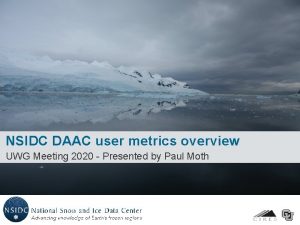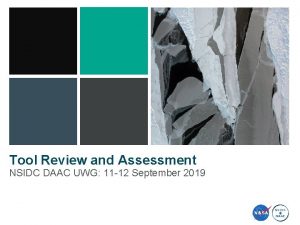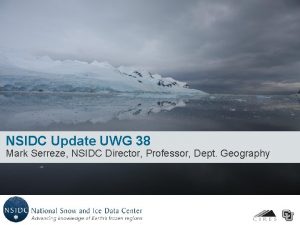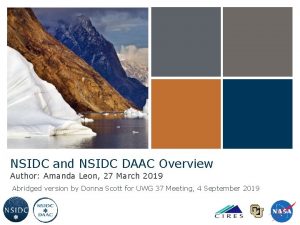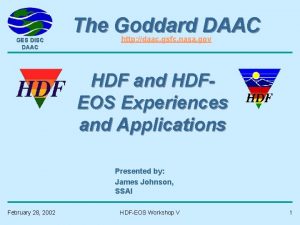DAAC Product Review NSIDC DAAC UWG Meeting 37









- Slides: 9

DAAC Product Review NSIDC DAAC UWG Meeting 37, 2019 Donna Scott

Background The data set baseline includes currently supported data sets, future data sets for which funding has been identified, and candidate data sets for which funding has not yet been identified, as well as services provided for each data. Per the Statement of Work, the DAAC is required to maintain a dataset baseline to meet the needs of the evolving cryospheric science community. To ensure this, the DAAC conducts product reviews with the UWG for non-EOS collections in the DAAC baseline (minimum every 5 years). Past Product Reviews During the last contract the product review was a large facilitated project reviewing 110 data sets. DAAC staff reviewed and created quad charts describing, assessing and recommending actions for each data set. UWG members were grouped based on expertise and complimentary data groupings. Virtual meetings were held to collect input and recommendations from the UWG. These recommendations included: § Potential Lo. S changes § Potential data set “retirement” and/or replacement § § Improvements to data set visibility Guidance on gaps in the data baseline catalog For this contract period, we are taking a more phased approach.

Plan for product evaluation, 2019 -2023 § Over the course of the five year contract, the DAAC will select particular data sets to review from the non-EOS collections § We will ask UWG members to participate in review exercises periodically throughout the year § Members will be chosen for review based on expertise § UWG members will be asked to contribute recommendations based on: § Overall value to the community § Usability (documentation, services provided, etc…) § Need for change in level of service § Where gaps may exist in the baseline data catalog (i. e. snow products)

Hands on training § During this session we will evaluate four data sets 1. RAMP AMM-1 SAR Image Mosaic of Antarctica, v 2 2. HDF 4 Data Used to Assess Long-Term Access to Remote Sensing Data with Layout Maps 3. Baltic Sea Experiment (BALTEX) Ground-Based Radar Polar Volume Data 4. GEOSAT Radar Altimeter DEM Atlas of Antarctica North of 72. 1 degrees South § We will break into two groups, facilitated by Donna & Amanda § RAMP, GEOSAT group § BALTEX, HDF group § Goal is to review the information provided on the quad charts, and provide a recommendation answering the specific UWG questions on the quad charts § At the end of the session each group will share their recommendations

Template Slide/Legend Explains the source of information for these charts Data Set Details • PI(s): From the Contacts and Acknowledgements section of the documentation. In older documentation, it may just be labeled Investigator. • Publication date: From the metadata • Updates: From the metadata/documentation • Parameters: Documentation • Temporal coverage/resolution: Documentation • Spatial Coverage/resolution: Documentation • Data File Format: Documentation; data files on FTP. • Current Level of Service: Provides information on the current assigned level of support for user support, data set documentation, and data set distribution. Data Set Metrics DAAC Recommendation • What does the DAAC recommend should be done with this data set and why? UWG Recommendation • Is this data set still valuable to the community or could it be if some changes were made (e. g. , format, updates)? • What does the UWG recommend should be done with this data set and why? • Download usage – Distinct Users • Number of publications citing this data: This is the number of publications we were able to find that directly cite the data.

RAMP AMM-1 SAR Image Mosaic of Antarctica, v 2 https: //nsidc. org/data/nsidc-0103 Data Set Details • PI(s): Jezek, K. C. , J. C. Curlander, F. Carsey, C. Wales, and R. G. Barry • Publication date: 2000 (version 1) • Updates: Version 2 3/12/2013 • Parameters: Backscatter • Temporal coverage/resolution: Sept, Oct 1997 • Spatial Coverage/resolution: Documentation • Data File Format: binary, Geo. TIF • Current Level of Service: Standard • Summary: The mosaic provides a detailed look at ice sheet morphology, rock outcrops, research infrastructure, the coastline, and other features of Antarctica, as well as representing calibrated radar backscatter data, which may provide insight into climate processes affecting the upper few meters of snow cover. DAAC Recommendation • The DAAC recommends that this data set lower the level of service from standard to basic. Though newer data sets exist, it still has a fair amount of use with publications citing the data. Data Set Metrics • Download usage from 2014 -2019: 1225 • Number of publications citing this data (google scholar): 25 since 2015, 7 since 2018. • User Support requests: Related to data access UWG Recommendation • Is this data set still valuable to the community or could it be if some changes were made (e. g. , format, updates)? • What does the UWG recommend should be done with this data set and why?

GEOSAT Radar Altimeter DEM Atlas of Antarctica North of 72. 1 degrees South https: //nsidc. org/data/nsidc-0075 Data Set Details • PI(s): Ute Herzfeld, Michael S. Matassa. • Publication date: From the metadata • Updates: From the metadata/documentation • Parameters: Glacier/Ice Sheet Elevation, Surface roughness, Terrain Elevation, Glacier/Ice Sheet Topography • Temporal coverage/resolution: 4/1985 – 9/1986 Spatial Coverage/resolution: N: -65, S: -72, E: 180, W: -180 • Data File Format: ASCII • Current Level of Service: Basic • Summary: The Antarctic atlas consists of digital elevation maps Data Set Metrics • Download usage from 2014 -2019: 351 • Number of publications citing this data google scholar: 0 • User Support requests: Related to data access which cover Antarctica at a resolution of 3 km. A geostatistical mapping technique (Herzfeld et al. 1993) improved the accuracy of surface elevations compared to previous GEOSAT elevation data sets. DAAC Recommendation • The DAAC recommends that this data set be retired due it being outdated and superseded by other Antarctic DEMs. UWG Recommendation • Is this data set still valuable to the community or could it be if some changes were made (e. g. , format, updates)? • What does the UWG recommend should be done with this data set and why? • Are there particular Antarctic DEMs that the DAAC should be considering, or providing visibility to?

HDF 4 Data Used to Assess Long-Term Access to Remote Sensing Data with Layout Maps https: //nsidc. org/data/nsidc-0397 Data Set Details • PI(s): Duerr, Ruth E. , and Jonathan Crider Publication date: 2/12/2018 • Updates: none • Parameters: n/a select data files/metadata • Temporal coverage/resolution: n/a • Spatial Coverage/resolution: n/a • Data File Format: HDF • Current Level of Service: Basic • Summary: This data set consists of a sampling of each type of HDF 4 data that are archived at the NASA DAACs. The data were sampled for a collaborative study between the HDF Group and select DAACs in order to assess the complex internal byte layout of HDF files. Methods for producing a map of the layout of the HDF 4 files were prototyped using a markup-language-based HDF tool. The resulting maps allow a separate program to read the file without recourse to the HDF application API. Data products selected for the study, and a table summarizing the results, are included DAAC Recommendation • The DAAC recommends that this data set be retired. It is outdated in its goal to educate the broader user community about the data sets NASA DAACs provide in HDF 4. Data Set Metrics • Download usage from 2014 -2019: 117 • Number of publications citing this data (google scholar): 0 • User Support requests: Related to data access UWG Recommendation • Is this data set still valuable to the community or could it be if some changes were made (e. g. , format, updates)? • What does the UWG recommend should be done with this data set and why?

Baltic Sea Experiment (BALTEX) Ground-Based Radar Polar Volume Data https: //nsidc. org/data/nsidc-0209 Data Set Details • PI(s): Bennartz, R. • Publication date: 4/29/2004 • Updates: n/a • Parameters: Radar Reflectivity • Temporal coverage/resolution: 9/2002 – 5/2003 • Spatial Coverage/resolution: 57 N, 18 E • Data File Format: Net. CDF • Current Level of Service: Basic • Summary: This data set includes non-Doppler polar volume reflectivity data from the Baltic Sea Experiment (BALTEX). Data were collected on Sweden's Gotland Island, using an Ericsson radar mounted at 56 m above sea level. DAAC Recommendation • This is a unique data set that may have offered value in satellite validation. There are few users, and it is outdated. The DAAC recommends that this data set be retired. Data Set Metrics • Download usage from 2014 -2019: 28 • Number of publications citing this data (google scholar): 0 • User Support requests: Related to data access UWG Recommendation • Is this data set still valuable to the community or could it be if some changes were made (e. g. , format, updates)? • What does the UWG recommend should be done with this data set and why?
